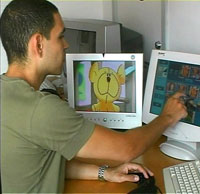In preparation for the upcoming SandboxSummit@MIT, I spent time with Harold Moss and Carla Seal-Wanner of FlickerLab , an educational content and technology studio in NYC. They gave me a demo of FlickerStudio, which they hope will not only remake the way media is made, but also remake the way media is used to teach, learn and entertain.
WS: Give me the elevator speech. What is FlickerStudio?
FL: FlickerStudio is a video-in-a-box that turns creating professional-quality media into a game-like experience. It uses revolutionary live-production technology and a powerful graphics engine to let users create and broadcast an entire HD production in real-time. It’s animation and production made so easy, that an eight-year-old can produce his own animated TV show, webisode, classroom presentation, newscast, or live production.
WS: We’re still on the elevator.
FL: FlickerStudio takes the place of an entire studio production crew, using a touch screen to create a complete production. With a single touch, users can control studio and web camera feeds, graphics, live animated characters, lighting and sound cues, camera control, games, social media feeds, and any other element that can be thrown into the mix. The whole show can be performed live, previewed on-screen in a preview window, and sent out in full, uncompressed HD, to disk or streamed live across all online and mobile video platforms or saved for later distribution at the push of a button.
WS: Sounds pretty intense. And kids need this…why?
FL: We believe visual literacy and media-making skills are key components of 21st century education.
WS: Are you saying reading, writing, and arithmetic no longer cut it for kids in the 21st century?
FL: The 3Rs will always be essential skills for literate citizens. The failure of our current educational system to engage kids in learning these basic skills is well documented. We are setting ourselves up for even greater failure if we don’t find effective ways to teach skills essential to stay competitive. In our media- and technology-saturated world, sophisticated visual literacy and media-making skills are crucial to stay informed, communicate, create and participate in society as a life-long learner.
WS: Do you see FlickerStudio mainly as a classroom tool?
FL: The short answer is yes. FlickerStudio is designed for the large swath of people who want to quickly create professional level videos and participatory shows, but don’t have professional level engineering and production know-how. Initially, our primary buyers will be both learning and production institutions.
However, as a classroom tool, FlickerStudio is amazing. We hope it ends up in every classroom in the world. The system both helps kids learn how to communicate through media, and works as a powerful tool for teachers to create and present media in classrooms, remotely and in informal learning settings. There are built-in connections to deep libraries of existing content, so for example, students and teachers can access PBS LearningMedia for clips or content on a whole range of curriculum-targeted subjects. In effect, FlickerStudio approaches the education issues we worry about from both sides.
WS: What are some of the ways you expect people will use FlickerStudio?
FL: Some of the alpha sites we are currently setting up give a sense of the kinds of uses we’ll see. A middle-school is integrating FlickerStudio into their curriculum to document performances and sports, teach journalism, build an after-school media making program, and to create a video news/morning announcements program created by students. The Whistle, a new sports network for kids, will be using FlickerStudio to produce their anchor sports news show, including live animation, live viewer feeds, and lots of interactive features to make the kids watching part of the show. The New York Hall of Science is integrating FlickerStudio into a major animation exhibit to let kids make their own cartoons, live. We are going to be using FlickerStudio to create live, streaming coverage of the World Maker Faire, combining live animated characters, multiple cameras, web-cams, live experimental data, graphics, and other interactive elements all through a single unit.
WS: With both 3-D Hugo and Avatar taking Oscars in the past few years, do you see a 3-D version of FlickerStudio coming soon?
FL: An integrated, 3-D environment capable of creating 3-D output is definitely on our longer term roadmap, though it is not our first priority. Our biggest focus is on continued development of an intuitive, play-based interface, the ease of integration with the widest range of external production equipment, nurturing the community of creators we are building around FlickerStudio, and allowing ease of output to the widest range of digital platforms like e-books, apps and games.
WS: What other applications do you hope will emerge?
FL: Two major applications are on the horizon. First, we’ll be expanding into mobile and cloud technology. To start with, this will show up as iOS apps allowing multiple users to collaborate on the same production through a single FlickerStudio system.
Our second area will be around the creation of customized educational content. FlickerStudio’s potential is as a content presentation tool for both in-class and remote learning applications. Entire, media-rich curricula, including videos, games, animated hosts, visualization tools, info-graphics and remote connections, can be packaged and made available to everyone.
WS: When and where will FlickerStudio be available?
FL: We’re targeting fourth quarter 2012 for release of version 1.0, which will be available through a network of over 700 resellers. Of course, KidScreen will know as soon as our release date is solidified. And attendees of SandboxSummit@MIT can see FlickerStudio in action!
Send me your comments! wendy@sandboxsummit.org





















